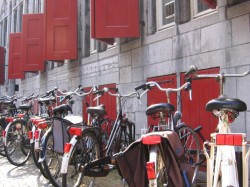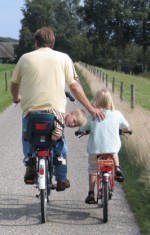How to Ride a Bike in Holland
How To: The country was made for pedaling, but before you hit the road, you'll need a few tips. Terry Ward explains how to roll like a Dutchman.
10.12.05 | 9:43 PM ET
 The situation: You’ve landed in Holland and want to explore the country like a local. One look at the bicycles spinning down the roads reveals the answer. With nearly as many bikes as people (13 million bikes, 16 million Dutchmen), pancake-flat Holland was made for pedaling. But before you hit the road here, your cycling know-how will need some fine-tuning.
The situation: You’ve landed in Holland and want to explore the country like a local. One look at the bicycles spinning down the roads reveals the answer. With nearly as many bikes as people (13 million bikes, 16 million Dutchmen), pancake-flat Holland was made for pedaling. But before you hit the road here, your cycling know-how will need some fine-tuning.
Who rides: All social classes ride bikes in Holland. In a country known for its practical thinking (a favorite Dutch saying, referring to how the Netherlands was reclaimed from the sea, goes like this: “God made the world, but the Dutch made Holland”), biking is the most logical mode of transport. Everyone, from grandparents to too-cool teens, takes to the roads by bike. Women master the art of discreetly pedaling in skirts and stilettos, and it’s not unusual to see a man in a $2,000 suit cycling home from the office. Explains Hilde Kievit, 32, a lawyer who lives in Zwolle: “We use the bike for everything—to do the groceries, go to work or visit friends in the city.”
The machinery: Typical Dutch bikes have a retro appearance and are designed for comfort above all else; many don’t even have gears or hand breaks. Because the landscape is so flat, the frames of typical Dutch city bikes don’t need to be as light as, say, mountain bikes. These are solid machines with plenty of room for practical attachments such as child seats, saddlebags for briefcases and baskets for groceries. For the ultimate comfort cruiser, ask for an “omafiets” (“grandma bike”). The wide saddle, low frame for easy mounting and high handlebars assure an effortless upright ride. The “opafiets” (“grandpa bike”) is the men’s version - just as comfortable, but equipped with that standard, if anatomically illogical, high bar stretching across the frame that lets the world know you’re a real man.
 Where to rent: Bikes are available for rent - by the day, week or month - at most major train stations in Holland, from Maastricht in the south to the northern city of Groningen. In the most visited spots, such as Amsterdam and Gouda, private companies offer rentals as well as bicycle sightseeing tours through cities and into the windmill-dotted, canal-crossed outlying areas. Expect to pay a minimum of 8 euros a day for a simple pedal-brake bike and up to 20 euros a day for the luxury of a hybrid bike with gears and manual brakes.
Where to rent: Bikes are available for rent - by the day, week or month - at most major train stations in Holland, from Maastricht in the south to the northern city of Groningen. In the most visited spots, such as Amsterdam and Gouda, private companies offer rentals as well as bicycle sightseeing tours through cities and into the windmill-dotted, canal-crossed outlying areas. Expect to pay a minimum of 8 euros a day for a simple pedal-brake bike and up to 20 euros a day for the luxury of a hybrid bike with gears and manual brakes.
Advanced technique: Riding double with another rider on a bike may look like a circus act in most countries, but in Holland it’s a completely practical way of getting around. The Dutch pull it off with grace, but doubling isn’t easy for the uninitiated. If you’re the one pedaling, make sure your passenger jumps on the rear platform once you’ve already started rolling for a more stable mount. If you’re riding “achterop” (sitting sidesaddle on the flat metal platform attached over the rear wheel), it’s all about balance. Use your stomach muscles to keep your legs from swaying and try to relax as much as possible while trusting your driver to do the rest.
Lock it or lose it: A Holland native who doesn’t have a stolen bike story would be, well, un-Dutch. Amsterdam is the bike theft capital of the world. In the back alleys of most Dutch cities, shifty-eyed junkies sell stolen bikes for around 20 euros while discreetly intoning, “Fiets kopen? Fiets kopen?” (“Buy a bike?”). It’s tempting, but supporting these guys just perpetuates two vicious cycles - drug abuse and bike theft. Nearly all Dutch bikes come with a built-in lock on the back wheel. But the bare minimum to combat thieves is a U-Lock to attach the frame to something solid. Most train stations offer bike storage complete with a security guard for a few euros a day. Some locals paint their bikes as garishly as possible - a nice pink and purple polka dot design, the thinking goes, might send a would-be thief elsewhere.
 Road rules: Designated bike pathways, usually closed to pedestrians, run alongside most roads throughout Holland, with separate traffic lights for bikers and cars at intersections and train crossings. As with driving, keep left while passing other bikers. Signal your approach to the person in front of you with a quick ring of your bell. It’s okay to bike alongside a friend (Dutch lovebirds often hold hands while pedaling), but don’t try to pedal three-wide.
Road rules: Designated bike pathways, usually closed to pedestrians, run alongside most roads throughout Holland, with separate traffic lights for bikers and cars at intersections and train crossings. As with driving, keep left while passing other bikers. Signal your approach to the person in front of you with a quick ring of your bell. It’s okay to bike alongside a friend (Dutch lovebirds often hold hands while pedaling), but don’t try to pedal three-wide.
True style: To ride like a local, the key is to stay as upright as possible and make it look effortless while being mindful of pedestrians, cars and other bikers around you. It’s all about riding with confidence. Explains Kievit, “Don’t hunch over, and use the strength in your legs to push without moving the rest of your body so much.” Finally, don’t forget to ring your bell—liberally.![]()
Photos by Terry Ward.